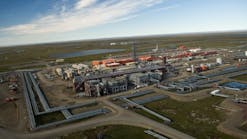Maugeri expects 17 million b/d more global oil production by 2020
Global crude oil production capacity is likely to climb to 110 million b/d by 2020 from 93 million b/d currently in the largest single-decade increase since the 1980s, a former senior Eni executive forecasts in a recent study.
The 17 million b/d surge will occur nearly everywhere, with the largest increases in Iraq, the US, Canada, Brazil, and Venezuela, said Leonardo Maugeri, a research fellow at the Geopolitics of Energy Project at the Belfer Center for Scientific and International Affairs at Harvard University's John F. Kennedy School of Government.
The study, "Global Oil Production is Surging: Implications for Prices, Geopolitics, and the Environment," also forecasts that technological advances in unconventional oil production will help the US experience unprecedented output and help make the Western Hemisphere energy self-sufficient by 2020.
"What's happening in North Dakota, particularly in the Bakken and Three Forks formations…and the Eagle Ford in Texas is the beginning of a big revolution, probably the biggest we've seen in the oil industry in decades," Maugeri said.
Tight oil production in the two states has grown from virtually nothing in 2010 to 1 million b/d, "which is incredible by any standard," he continued. The combination of hydraulic fracturing and horizontal drilling will make it possible to exploit US tight oil plays, "and there are plenty," and open up a new era, Maugeri said.
"By 2020, thanks to production from tight oil formations, the United States could be the world's second oil producer in the world after Saudi Arabia," he said.
Price implications
Maugeri said increased global production potentially could make prices collapse. Investments could sustain the 20% production capacity increase if price stay at or above $70/bbl, he explained. But with world demand sluggish due to the sluggish economy and growing emphasis on energy efficiency, a significant dip or even a collapse in prices is possible, he said.
"If I'm right, and this new production makes its way onto the market, we will face sooner or later a collapse of oil prices," Maugeri said. "Depending on [its] timing, the consequences could be short-term or long-term."
Major emissions reduction technology investments will need to accompany this coming oil boom to respond to growing enforcement of regulations, the study indicated. New oil production projects could be stymied or delayed without a balance between industry and environmental interests, it said.
Maugeri said his study was unique because it began with a huge proprietary base of the world's existing oil fields, a field-by-field analysis of investments, and production targets from those investments. "Then I made my assumption about risk factors, depletion, and reserve growth," he said.
"It's a kind of bottom-up analysis that is unique because usually this kind of study is based on macroeconomic, econometric models and not on the reality of the bottom-up production under way," Maugeri said.
More Oil & Gas Journal Current Issue Articles
More Oil & Gas Journal Archives Issue Articles
View Oil and Gas Articles on PennEnergy.com

Nick Snow
NICK SNOW covered oil and gas in Washington for more than 30 years. He worked in several capacities for The Oil Daily and was founding editor of Petroleum Finance Week before joining OGJ as its Washington correspondent in September 2005 and becoming its full-time Washington editor in October 2007. He retired from OGJ in January 2020.
